Easy No Carve Pumpkin Decorating Ideas for Kids 23 Oct 12:19 AM (yesterday, 12:19 am)
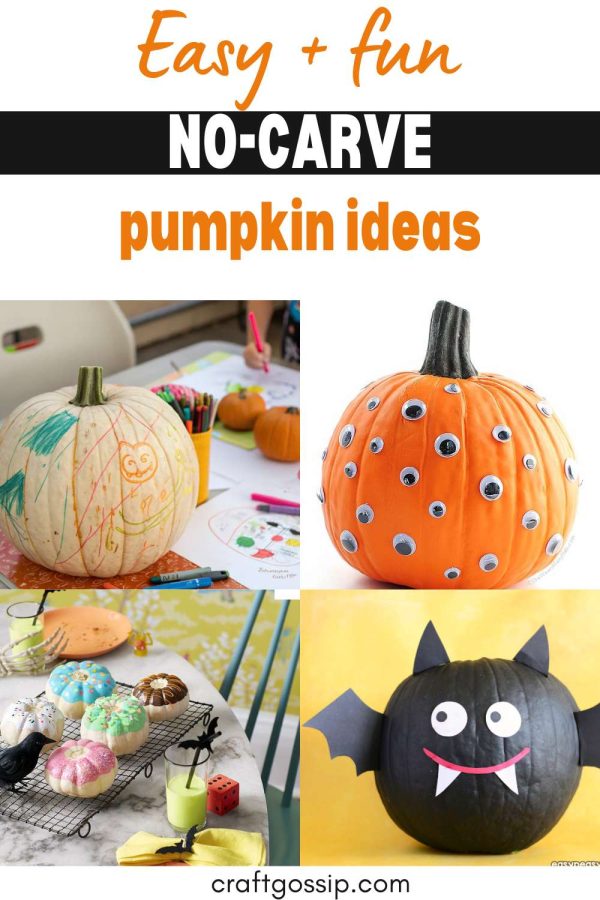
 With Halloween right around the corner as I write this, you might be looking for some ways to decorate pumpkins for kids without carving. Whether you’re doing this as a classroom or at home, there are a lot of fun ways to decorate pumpkins that don’t require sharp instruments.
With Halloween right around the corner as I write this, you might be looking for some ways to decorate pumpkins for kids without carving. Whether you’re doing this as a classroom or at home, there are a lot of fun ways to decorate pumpkins that don’t require sharp instruments.
Painting: A couple of years ago my daughter decided she wanted to paint a scene on our pumpkin instead of carving. She’s a teen and legitimately an artist, so it turned out beautiful, but kids of any age and artistic skill level can paint a pumpkin (and we definitely have had some more chaotic versions over the years). If you’re looking for some specific ideas on painting pumpkins, this post from Parents has a view good ideas. I love the emojis and the mini pumpkins painted as doughnuts, shown above.
Add Accessories: Easy Peasy and Fun has a great collection of (mostly) simple painted pumpkins that are embellished in different ways to make them a little more fun. I love this little bat, which only requires painting the pumpkin black and adding embellishments made with construction paper.
Drawing: If you don’t want to get out the paint, using markers (or paint pens, or oil pastels) to draw on a pumpkin can also be a lot of fun. This is especially effective on a light-colored pumpkin. (The photo above is from Casolia, by the way.)
Stickers: It’s almost universal that kids love sticking stickers to things, so why not give them a pumpkin and whatever stickers you have lying around (seasonally appropriate ones or eyes would be great, but not essential) and let them go to town.
Googly eyes: Speaking of eyes, if you’ve got a supply of peel and stick googly eyes (or the patience to use glue), adding eyes to a pumpkin is a fun and easy way to make a pumpkin spooky with very little work. This version comes from She Wears Many Hats.
You can also combine any of these ideas, so start with painting, then add stickers and/or eyes and just keep building from there. Maybe throw in some feathers and your pumpkin will be all set for Thanksgiving, too.
How do you like to decorate pumpkins with kids? I’d love to hear your ideas!
Fox Learning Activities for Kids 18 Oct 8:22 AM (6 days ago)
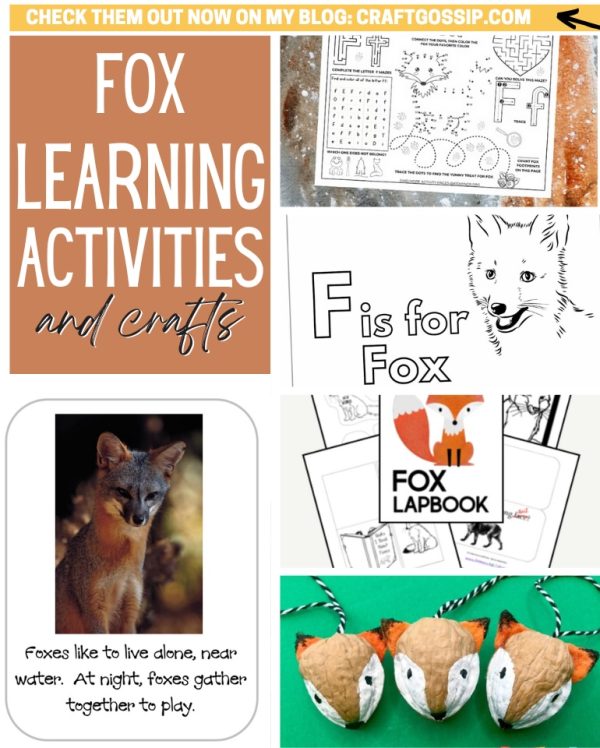
 I don’t know why I think of foxes as being a fall animal, but here we are, so let’s explore some learning activities and crafts to do with foxes.
I don’t know why I think of foxes as being a fall animal, but here we are, so let’s explore some learning activities and crafts to do with foxes.
By the way if you’re looking for arctic fox materials, we’ve got you covered for that, too.
Start out with some fun facts about the red fox from Our Lively Adventures. If you want to learn more about the different kinds of foxes, check out these pages from National Geographic Kids:
There are actually 24 different species of fox, and you can learn a little about all of them from Trillium Montessori. (The fennec is my favorite!)
Grab a free fox lapbook printable from Homeschool Share that includes a ton of great information for kids. There’s a mini book to read, information about types of foxes and predator vs. prey, plus information about where foxes live, how they communicate and why their tails are so special.
Mudpies and Makeup has a cute set of free printables with foxes, including fact cards, clip counting cards, fox rhymes, a puzzle, size sorting and more. These are a great way to learn a little about foxes and also do some basic activities with foxes as the theme.
If you’re able to pay for resources, this fox fact booklet from The Breezy Teacher is cute and includes a printable fox mask craft. I also like the set from Montessori Nature, which includes the parts of a fox, life cycle, three-part cards, learning booklets and more.
I love this fox ornament made out of a walnut shell! This would be a good craft for older kids and it makes a great holiday ornament for the tree. You can get the instructions from Red Ted Art.
Kid Minds has a cute fox activity sheet printable that includes connect the dots, a maze, trace the letter f, find the letter and more. This is a good time filler at home, in the classroom or when you’re out to eat. Nature Inspired Learning has some nice realistic looking fox coloring pages as well.
Book Review: The Land Knows Me 16 Oct 8:51 AM (8 days ago)
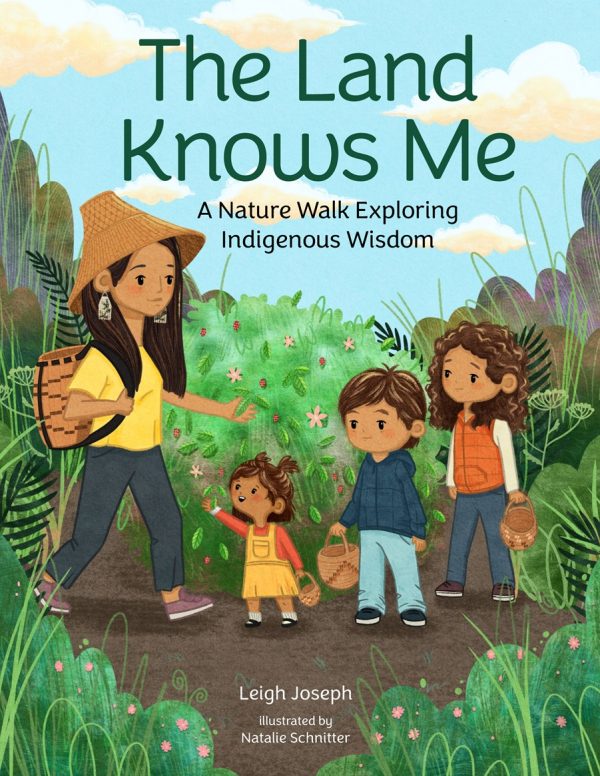
 Any time is a good time to read more indigenous stories, but as we get closer to Thanksgiving in particular it’s nice to take some time to learn about the people who were here before colonists came, and who still practice a traditional relationship with the earth.
Any time is a good time to read more indigenous stories, but as we get closer to Thanksgiving in particular it’s nice to take some time to learn about the people who were here before colonists came, and who still practice a traditional relationship with the earth.
The Land Knows Me: A Nature Walk Exploring Indigenous Wisdom by Leigh Joseph and illustrated by Natalie Schnitter, takes readers on a walk in the Pacific Northwest to learn about plants and animals important to the Squamish people.
The book follows a family on a plant walk, talking about what they bring for themselves and for the plants they are going to visit. Because the plants and animals are considered family, it’s respectful to greet them and bring them gifts, especially if you’re going to harvest some of the plants for medicine or food.
They see and harvest various plants and talk about their uses, such as wild rose petals being good for bug bites to relieve itching, or crab apples and the bark of the tree being used in both food and medicine. Cottonwood buds are used to make a salve for achy bodies, and salal berries are great for drying into fruit leather.
Illustrations are colorful and cute and show how different plants and animals share habitats in the forest.
The overarching theme is that nature is a community just like the human community, and plants and animals rely on each other just as we rely on them. It also touches on the importance of cross-generational discussion and the passing on of knowledge about the plants that are important to a culture.
The book includes words in Squamish and how to pronounce them, as well as their meanings in English. There are also tips for readers who might want to go on their own plant walk, such as noticing what plants and animals are around and thinking about places in nature that are special to you.
There are also some sidebars with extra context such as talking about how Squamish people give thanks for the plants and what a nurse log is.
At the back of the book there are tips for harvesting wild plants sustainably, as well as field notes about the different plants that are included in the book. These notes include the plant’s habitat, how it is used by the Squamish, how to harvest and any safety tips. There are also recipes for things like honey infused with red currant berries.
Even if you don’t live in the Pacific Northwest, The Land Knows Me is a lovely introduction to indigenous culture and how people and plants and animals are connected for kids ages 6-11. This book focuses on spring plants, but it’s a nice read any time of year to get you thinking about and looking for useful plants where you live.
About the book: 80 pages, hardcover paper over boards. Published 2025 by becker & meyer kids. Suggested retail price $18.99.
Dia de los Muertos Crafts and Activities 14 Oct 8:28 AM (10 days ago)
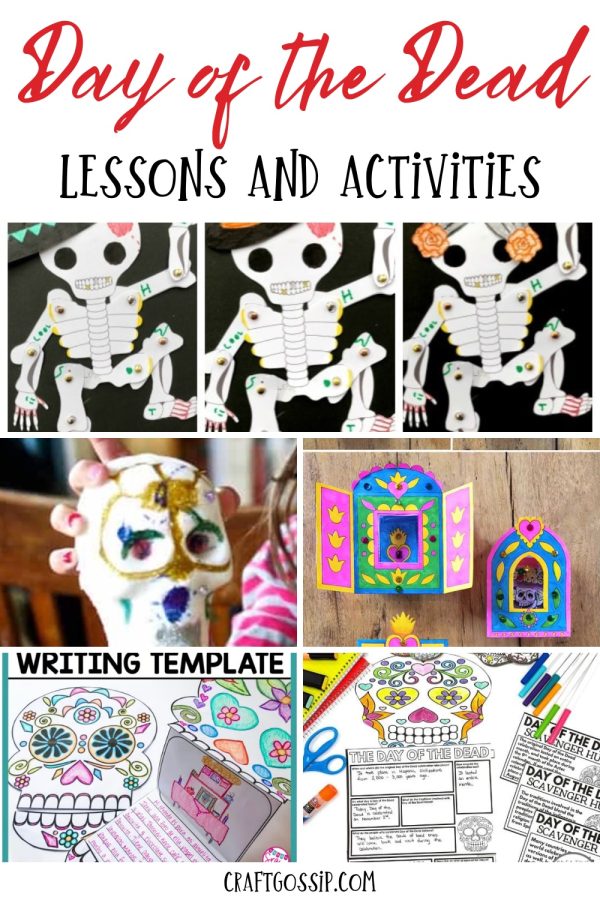
a de Last month I shared a review of The Dia de los Muertos Story and I wanted to share some more activities you can do at home or in classroom around the holiday.
Last month I shared a review of The Dia de los Muertos Story and I wanted to share some more activities you can do at home or in classroom around the holiday.
First off, if you want to learn more about the traditions and symbols surrounding dia de los muertos, there’s a good post at Llamitas Spanish (the post is in English) that includes activity ideas, authentic videos to help kids learn and more.
Teachers Pay Teachers has lots of great content for the day. A couple I ran into include this skull writing template in both English and Spanish that also includes blank prompts so you can write your own questions (this one is from Sra Cruz) and these activities for middle school including close reading, comprehension activities and more, which you can read about at Creative Classroom Core or buy direct from TpT.
Skeletons are a popular symbol of the day since it’s all about remembering and honoring people who have died, but they’re generally cute because it’s not meant to be scary. Red Ted Art has a set of printable skeleton puppets with joints so you can pose the arms and legs in different ways. They also have accessories you can mix and match so each person can make their own design.
This little nicho box from Happy Thought is another easy craft you can make and use to talk about loved ones who have died. There is one printable version that is free to download and others you can purchase (along with other activities) if you want more variety.
Hola Jalapeno has a recipe for making your own sugar skulls (which are not for eating because they’re decorated with non-food things). You’ll need a skull mold for these, but if you want to do this activity year after year it’s worth it to have one or several.
If you want a dia de los muertos treat you can eat, try pan de muerto, a sweet and savory bread that’s a classic this time of year. Latino Foodie has a good recipe. Be aware that because this is a yeast bread it’s not a quick project, but it’s a great one to make at home.
Check out more dia de los muertos activities here.
STEM Activities Using Cranberries 10 Oct 8:32 AM (14 days ago)
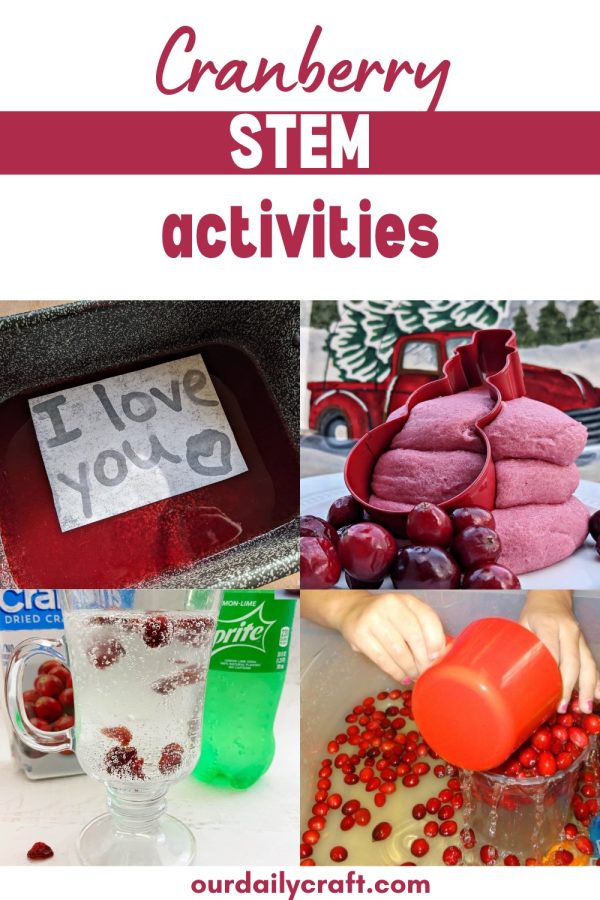
 Cranberries are such fun little fruits, and kids might not have exposure to them as actual fruits (unless you live where they grow). They’re also fun to use in STEM activities this time of year, so let’s check out some cranberry STEM ideas.
Cranberries are such fun little fruits, and kids might not have exposure to them as actual fruits (unless you live where they grow). They’re also fun to use in STEM activities this time of year, so let’s check out some cranberry STEM ideas.
Little kids and those who haven’t been exposed to cranberries as berries before will enjoy exploring them in a cranberry sensory bin. Fun Early Learning has ideas for how to set up a sensory bin using cranberries and what else to add.
Build structures with cranberries and toothpicks like in this idea from Artful Parent (the post shows grapes but there’s a link on the same post that mentions doing it with cranberries, but it links to this same URL so you’ll just have to imagine what it looks like.
Lots of classic STEM experiments can be done with cranberries. For example, the dancing raisins experiment can become a dancing cranberry experiment, like is shown at Little Bins for Little Hands. They used craisins (dried cranberries) for this experiment, but you can also try it with regular cranberries and see if that works.
Little Bins for Little Hands has a nice collection of cranberry activities including a more detailed activity building with cranberries and toothpicks, sink or float, sensory bin and more.
Did you know you can make invisible ink using cranberry juice and baking soda? Get the recipe from Kid Minds. They made their own juice from fresh cranberries; I’m not sure if purchased cranberry juice would be acidic enough for this to work. But you could try both and compare and make it a full science experiment where you talk about why it does or doesn’t work.
While you’re making your own cranberry juice you can also use it to make cranberry scented playdough. This idea is also from Kid Minds and is another fun way to play with cranberries.
Easy Halloween Crafts for Kids 8 Oct 7:41 AM (16 days ago)
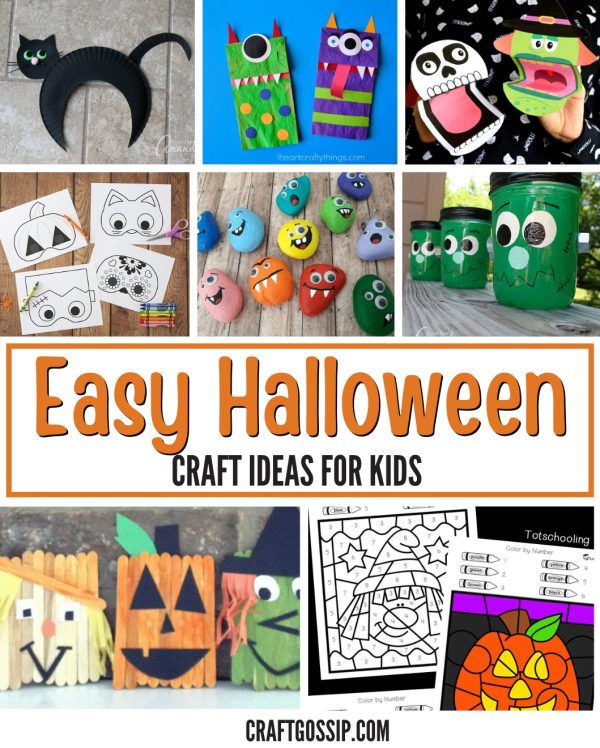
 Whether you’re looking for a craft for the classroom or a Halloween craft you can do at home even if you’re not crafty, these easy Halloween crafts for kids offer some great options.
Whether you’re looking for a craft for the classroom or a Halloween craft you can do at home even if you’re not crafty, these easy Halloween crafts for kids offer some great options.
If you want to keep it super simple, print out and color these Halloween masks from It’s Always Autumn. Options include a cat, pumpkin, Frankenstein’s monster and a dia de los muertos style sugar skull. Just print, color, cut out and you’re ready for a Halloween parade.
Or do some cute color by number printables like these from Tot Schooling. Color a pumpkin, witch, Frankenstein’s monster or bats and use them to decorate the classroom.
Crafts by Amanda has this cute and classic paper plate black cat project, which comes with a printable template. Older kids can be shown the shape you’re going for and cut out their own if you’d rather.
Also in the category of crafts you can make with things you probably already have in the house are these cute paper bag monsters from I Heart Crafty Things. If you give kids paint, paper and eyes they are sure to come up with fun versions of these all on their own, which would make a great classroom display.
Easy Peasy and Fun has another take on Halloween puppets with these printable puppets for a skeleton, witch, pumpkin and vampire. Print, color and cut out for some easy fun.
If you want a slightly more involved but still pretty easy fall or Halloween craft, check out these Popsicle stick creations from Life Beyond Laundry. Her post shows a witch, scarecrow and pumpkin, but you could make other things like a cat, Frankenstein’s monster or whatever characters the kids like.
Speaking of Frankenstein’s monster, I love these monster luminaries from Crafts by Amanda. They’re so easy to make and a little creepy cute. This one, too, could be remixed a bunch of different ways to make a pumpkin, witch or something else cute. These could also be used as vases or for storage if you don’t want to light them up.
Or try painting rocks to look like monsters or other Halloween creatures with this craft idea from The Inspiration Edit. All you need is rocks, paint, googly eyes and glue to make a bunch of fun and funny monsters.
Learn about Cuba for Kids 6 Oct 9:03 AM (18 days ago)
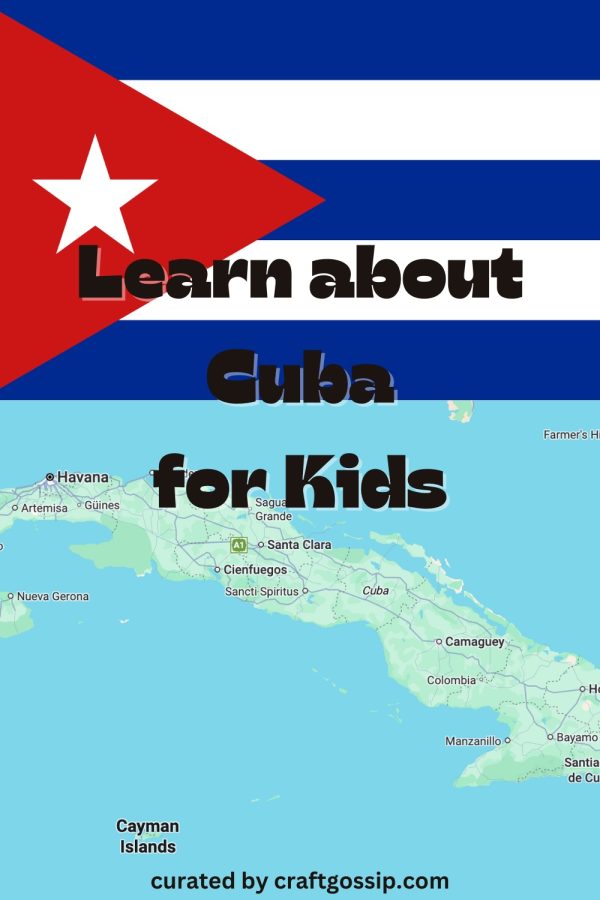
 Cuba is a island nation in the Caribbean that I feel like we generally think of as being one island, but there are actually more than 4,000 islands, islets and cays that are part of the country. Let’s learn more about Cuba!
Cuba is a island nation in the Caribbean that I feel like we generally think of as being one island, but there are actually more than 4,000 islands, islets and cays that are part of the country. Let’s learn more about Cuba!
Cuba Basics
The total land area of Cuba is 42,800 square miles, or 110,860 square kilometers. It has a population around 10 million people, making it the third most populous country in the Caribbean.
The largest city and the nation’s capital is Havana. The main island is known as Cuba and the second largest island is Isla de la Juventud, or Isle of Youth. The national language is Spanish.
It is about 93 miles/150 km from Key West, Florida; 14 miles/22.5 km from Cay Lobos in the Bahamas; and 130.5 miles/210 km from Mexico’s Yucatan Peninsula. Haiti and Jamaica are also close neighbors.
Humans first settled in the area around 6,000 years ago, with the Taino people inhabiting the region about 1,700 years ago. The Spanish colonized Cuba after Christopher Columbus landed there in 1492, and it struggled for independence through the late 1800s. The nation was a republic from 1902-1959, but this time included revolution and a coup. In 1959 forces led by Fidel Castro took over the country and the country has been under communist control ever since.
The country has been under an embargo by the United States since 1960, which largely cut off travel and economic support between the countries. The country’s exports are primarily tobacco, sugar and alcohol, and tourism (mostly from Canada and Europe) is a large contributor to the economy. The minimum monthly wage amounts to about $81 US a month.
Cuban National Symbols
The Cuban flag features three horizontal blue stripes broken up by white stripes, with a red triangle on the left side that has a white five pointed star in the center. The flag was designed in 1849 and officially adopted in 1902. The blue stripes represented the three departments the country was divided into at the time, while white represents purity of the patriots’ cause. The red triangle is for strength and unity.
The Cuban national anthem is known as La Bayamesa or “el Hymno de Bayamo” (The Bayamo Anthem) and was first performed during the Battle of Bayamo in 1868 as the Cubans fought for independence from Spain.
The national flower is the white mariposa, or jasmine butterfly, which was a favored flower of national hero and poet Jose Marti. He used the flower as a symbol of Cuban identity in their struggle for independence.
The royal palm is the national tree, and the national bird is the tocororo or Cuban trogon, which is red, white and blue like the Cuban flag and it’s often said if they are caged they will die.
Mamey sapote is the national fruit. Its orange flesh is said to taste like a sugary sweet potato.
Cuba Activities for Kids
Peanut Butter Fish Lessons has a free Cuban unit study for homeschool, and the page includes a couple of good videos for kids, too. KidsKonnect also has printable fact sheets and worksheets to use at home or in the classroom.
Global Explorers Club has a great looking paid unit study about Cuba, and you can find tons of resources for kids of all ages at Teachers Pay Teachers.
Want to make some Cuba themed crafts? Check out this collection from Artsy Craftsy Mom. Kindergarten Worksheets and Games also has Cuba coloring pages. Kids Activities Blog also has printable fact sheets you can color, and Puzzles to Print has a Cuba word search.
Play a game of dominoes, considered the national game of Cuba, or watch their national sport, baseball!
Danzón is considered the national dance, which you can watch on YouTube and learn more about from the Library of Congress.
Try the national dish, ropa vieja, which literally means old clothes and refers to the tender shreds of meat in the stew. This recipe from A Sassy Spoon is a great one (and the blog is full of Cuban recipes if you want to try something else).
Book Review: Bold, Brilliant, and Latine 4 Oct 7:42 AM (20 days ago)
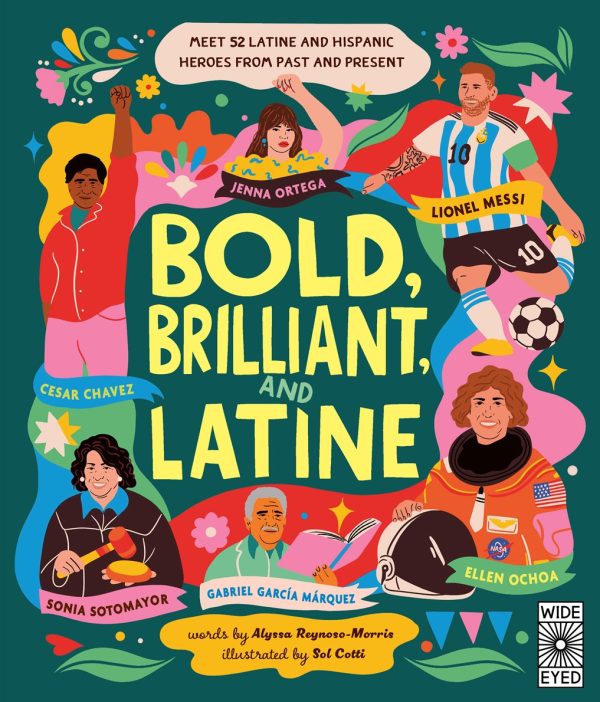
 If you’re looking for new books for your classroom for Hispanic Heritage Month or want some more pioneers of color to talk about at home or in class, check out Bold, Brilliant, and Latine by Alyssa Reynoso-Morris and illustrated by Sol Cotti.
If you’re looking for new books for your classroom for Hispanic Heritage Month or want some more pioneers of color to talk about at home or in class, check out Bold, Brilliant, and Latine by Alyssa Reynoso-Morris and illustrated by Sol Cotti.
This book features the stories of 52 Hispanic and Latine history makers past and present, complete with cute and colorful illustrations and a brief story about what makes them noteworthy.
It’s in chronological order so it starts with people your students (and you!) may not have heard of, like Victoria Montou, born Abdaraya Toya, who was abducted and enslaved in Haiti and helped train and fight along with other enslaved people in the Haitian Revolution. Or José Francisco Morazán Quesada, a military commander who helped liberate Honduras and was later president of the Federal Republic of Central America.
There are also more familiar names like Frida Kahlo, Celia Cruz, Gabríel Garcia Márquez, Cesar Chavez, Oscar de la Renta and Sonia Sotomayor. You’ll learn about the first Latina in space (Ellen Ochoa), a fighter for indigenous rights in Guatemala (Rigoberta Menchú), a three-time world surfing champion from Peru (Sofía Mulánovich) and a transgender woman who fought for justice for LGBTQ+ folks in New York (Sylvia Rivera).
The book includes musicians like Selena and Gloria Estefan, athletes like Lionel Messi and Roberto Clemente, entertainers like Guillermo del Toro and Lin Manuel Miranda, and actors like Salma Hayek and Jenna Ortega. You’ll also find scientists, politicians, activists and others who have made a mark in their field and on history.
Most of the people are presented in a single page with a drawing and a few paragraphs of biography. It’s enough to get people interested in learning more without going on for too long (this is a book for grades 2-5, after all). It might serve as inspiration to get kids to learn more about some of these figures and will definitely give you some people to talk about in history and other fields who are Latine and Hispanic.
About the book: 64 pages, hardcover. Published 2025 by Wide Eyed Editions. Suggested retail price $24.99.
Hispanic Heritage Month Activities for Kids 2 Oct 6:18 AM (22 days ago)
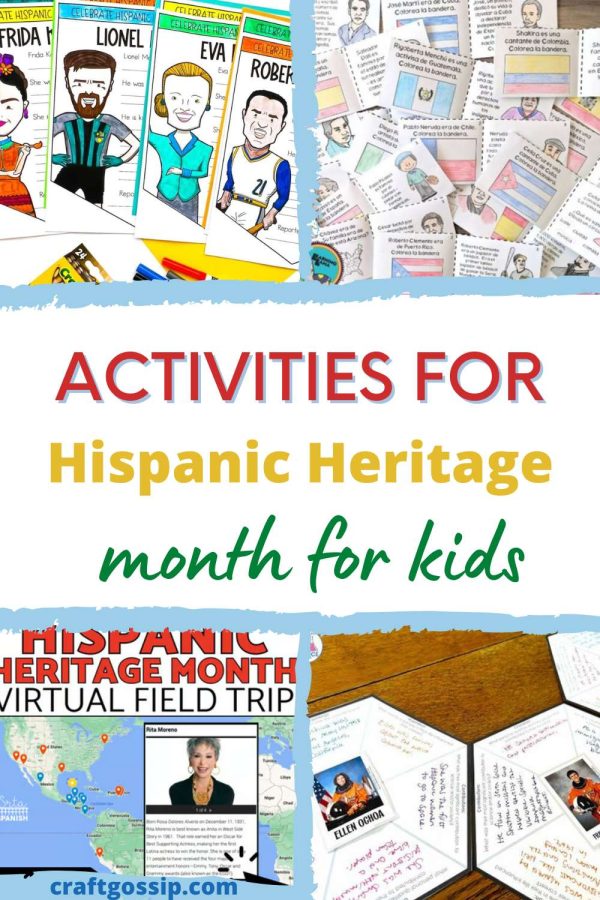
 Hispanic Heritage Month runs from Sept. 15 to Oct. 15, and it’s a great time to learn about Hispanic artists, scientists and others who have influenced the world.
Hispanic Heritage Month runs from Sept. 15 to Oct. 15, and it’s a great time to learn about Hispanic artists, scientists and others who have influenced the world.
My daughter’s Spanish class is doing all sorts of fun projects (she’s highlighting murals in our area painted by Hispanic artists) and project based learning is a great way to learn about different Hispanic figures.
For example this collaborative poster project from Easy Fun Science at Teachers Pay Teachers has kids learn about different Hispanic scientists and share information that’s put together into a display.
Srta Spanish has a virtual field trip built into an interactive Google Map showing different figures from around the world. The videos and readings are in English, though it would also be great for a Spanish class. Kids can just use the information in this project (there are comprehension questions included) or pick a figure from the presentation to learn more about.
For kids who do speak Spanish, the resources from The Llearning Llama are a lot of fun for the classroom. There’s a would you rather game, a quiz to determine which famous Hispanic person you are, foldable books about 24 Hispanic figures and more. You can learn about the resources on the blog and find tons of paid resources at Teachers Pay Teachers.
Real Life in the Classroom has a nice breakdown of how to research people and has some free printables (and more at Teachers Pay Teachers) to make it easy to make a display of their reports. Of course you can also have kids draw and write their own reports if you want to cover people who aren’t included in her list.
Woo Jr. has some good basic information you can build a lesson on, such as definitions of Hispanic and Latino, a country list and word search of country names, and a few biographies of Hispanic people in different fields. There’s also a notebooking page for learning about different countries if you want to include that in your lessons, as well as other ideas.
Labubu Coloring Pages and Activities 29 Sep 7:54 AM (25 days ago)
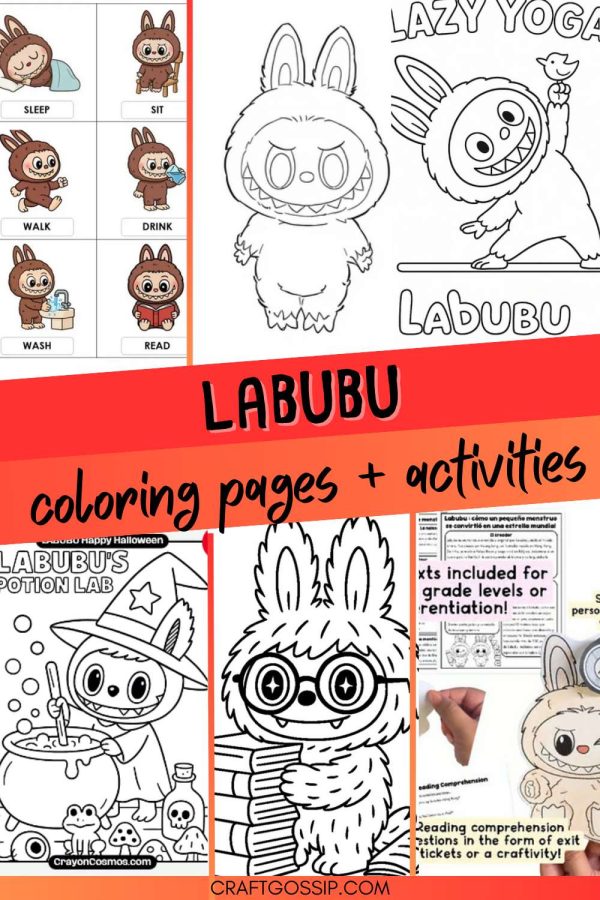
 If your kids have gone gaga for Labubu, you aren’t alone. These cute (or are they creepy cute?) little figures seem to be everywhere among a certain age group, so let’s capitalize on that interest with some Labubu coloring pages and other activities.
If your kids have gone gaga for Labubu, you aren’t alone. These cute (or are they creepy cute?) little figures seem to be everywhere among a certain age group, so let’s capitalize on that interest with some Labubu coloring pages and other activities.
These Labubu coloring pages are great to have on hand in the classroom for early finishers or in the art area.
Free Coloring Pages for Kids has 16 printable coloring pages featuring Labubu-like characters doing various things, even reading a book as shown above.
If you’re already looking ahead to Halloween, Crayon Cosmos has a whole set of Labubu coloring pages with a spooky season twist. These might be fun for your classroom Halloween party or to give away to kids at trick or treating.
Print and Color has a set of Labubu pages with the critter with different hoods, and there’s another set with a variety of looks (including some with text) available at Smooth Draw. And there are 23 more Labubu coloring pages available from Monday Mandala.
Find even more options at Blaster Junkies and Colorings.
If you want something more than coloring pages, there are some Labubu activities available as well. Shalahna ABA on Etsy has a set of printable flashcards with action words on them, which are great for ESL and early childhood.
Mme Rainbows at Teachers Pay Teachers has a cute Labubu craft and writing activity with three levels of text about the toy that work for different grades 2-6. They then answer questions and decorate a Labubu, which you can display in the classroom. This one also has options for English, French and Spanish learners.
And Happily Ever Elementary (also on TPT) has a super cute editable and printable welcome back bulletin board (which you could also use later in the year). You can add students’ names to one of 12 different Labubu characters and there’s a teacher doll as well. They also have a back to school writing activity that includes different Labubu bodies and school supplies kids can combine into their own creations, plus writing prompts for what they’re excited about in the new school year.
Spider Crafts for Kids 27 Sep 8:29 AM (27 days ago)
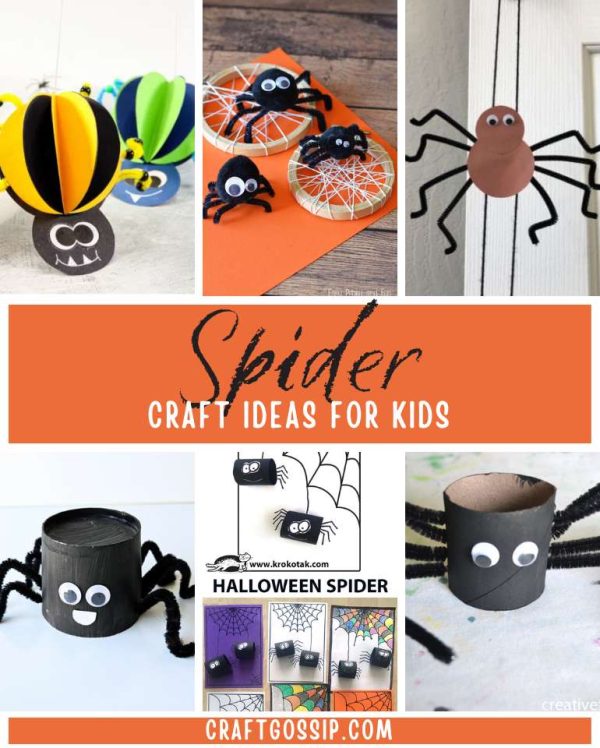
 Spiders are amazing all year, but we generally only make spider crafts during Halloween season. Whatever time of year it is when you read this, it’s always a good time to remember that spiders (generally) aren’t scary! Let’s take a look at some fun spider crafts for kids.
Spiders are amazing all year, but we generally only make spider crafts during Halloween season. Whatever time of year it is when you read this, it’s always a good time to remember that spiders (generally) aren’t scary! Let’s take a look at some fun spider crafts for kids.
A cardboard tube and pipe cleaner spider is a classic, and this one from Creative Family Fun is a good one. Other than painting the tube it’s a pretty quick craft, too, and even little kids can help make it.
Use a tube or make your own out paper to add to this printable spiderweb scene from Krokotak. This is such an easy one but kids will have fun building a scene around their spiders.
Or how about a pompom spider? This idea from Easy Peasy and Fun uses pipe cleaners and a black pompom to make the spider, and has the added (cute!) aspect of a spider web made on an embroidery hoop.
You can also make an easy spider out of a paper cup, like this one from Raise Curious Kids. Thriving Parenting has a similar one that has lots more eyes if that’s something your kids will enjoy (it definitely ups the creepy factor!).
Or give your spider a 3-D look with paper with this idea from Arty Crafty Kids that includes a printable template for making the head and the back pieces.
If your kids love “The Itsy Bitsy Spider” they’re going to love making this climbing spider craft from Mom Brite. There’s even a lesson in friction in here, so you can turn craft time into science time as well.
Make a printable paper spider that kids can decorate and assemble with this free template from Learn Create Love. This way kids can decorate their spiders any way they want, get cutting and assembly practice and they can put their spider in a scene they draw or paint, too. So much fun!
Book Review: Halloween 25 Sep 7:59 AM (29 days ago)
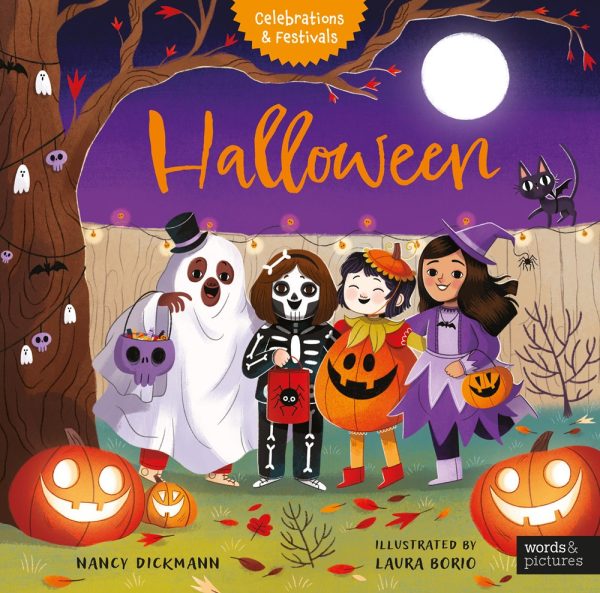
 Halloween is a holiday that many kids in America (and increasingly around the world) know about, but if you want to approach learning about Halloween as part of fall traditions, Halloween by Nancy Dickmann is a nice addition to your Halloween library.
Halloween is a holiday that many kids in America (and increasingly around the world) know about, but if you want to approach learning about Halloween as part of fall traditions, Halloween by Nancy Dickmann is a nice addition to your Halloween library.
Illustrated by Laura Borio, the book tells the story of Luna and her family as they celebrate fall and get ready for Halloween. They go to the pumpkin patch, make decorations and costumes and decorate pumpkins (one of which looks like a sugar skull so you can tie this book to Dia de Los Muertos as well).
The family throws a party with special snacks like candy apples and hot dog mummies, and they take part in a trunk or treat activity as well as traditional door to door trick or treating. (Spoiler alert: Luna’s view on candy corn may be a little controversial.)
The book emphasizes that Halloween is about creativity (and candy) not really scary stuff.
And while it’s not part of the main story, there is a section in the back about traditions that lead to our modern day Halloween celebrations, such as the Celtic festival of Samhain, the Catholic All Saints and All Souls’ days. It also talks about Halloween traditions like carving pumpkins, wearing costumes and trick or treating.
It also touches on Dia de Los Muertos, the Hungry Ghost Festival in China and other parts of Asia, Pitru Paksha (a Hindu celebration when ancestors are said to visit earth) and the Japanese Obon festival.
There are instructions for making a pumpkin pinata, frozen banana “ghost pops” and a couple of ways to make spider webs. There’s also a little quiz at the back.
This is a great book for an overview of what people do on and around Halloween for students who might not have that tradition, or as a way to talk about what their families do in the fall, regardless of whether they celebrate Halloween. You can also use it to get into a “best candy” debate.
About the book: 48 pages, hardcover. Published 2025 by words & pictures. Suggested retail price $14.99.
Pumpkin Crafts for Kids 23 Sep 6:43 AM (last month)
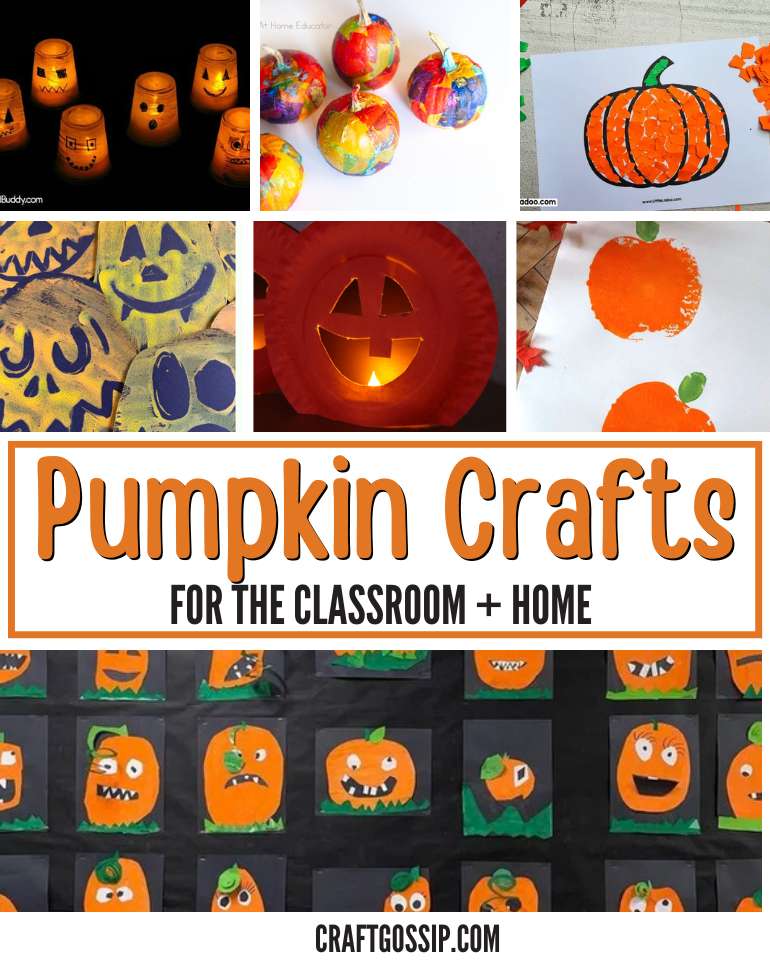
 It’s been a while since I’ve done any pumpkin related content (though there’s been a lot in the past including crafts, STEM activities, sensory ideas and even pumpkin printables!) so let’s explore some more pumpkin craft ideas for kids.
It’s been a while since I’ve done any pumpkin related content (though there’s been a lot in the past including crafts, STEM activities, sensory ideas and even pumpkin printables!) so let’s explore some more pumpkin craft ideas for kids.
Tearing paper is a great fine motor skill practice for little kids. Add in gluing, too, and this torn paper pumpkin from Little Ladoo is not only cute but building skills your little one needs. How great is that?
You can tear or cut the tissue paper you use to “paint” these mini pumpkins. Stay at Home Educator has this DIY, which is a cute alternative to painting pumpkins with a little less mess.
These easy glowing jack o’lanterns are a fun project for kids of all ages. Start with a clear plastic cup and you’ll have a bunch of glowing pumpkins in no time. Get the tutorial from Buggy and Buddy.
Make a couple of paper plates into a jack o’ lantern lit with an LED candle with this cute idea from Easy Peasy and Fun. You may already have the supplies you need for this one. Little kids can draw the face and have an adult cut it out for them.
I think kids of a variety of ages would also like this jack o’ lantern monoprint project from Kitchen Table Classroom. Monoprint sounds complicated but you just need paint and some kind of smooth, flat surface to work with and you’ll be printing pumpkins in no time!
A great one for the classroom that can be used as decoration is this goofy pumpkins art project from Mme Marissa. She shows the results from both kindergarten and a grade 2/3 classroom, so it’s great fun for everyone.
Crafters (and probably others) know that apples and pumpkins can look similar as creative motifs, and this project from In the Kids Kitchen takes that observation literally by using an apple to stamp a pumpkin shape. It’s so cute and easy, and if you cut the apples ahead even little kids can do it.
Learn About Animals on Different Continents 22 Sep 12:33 AM (last month)
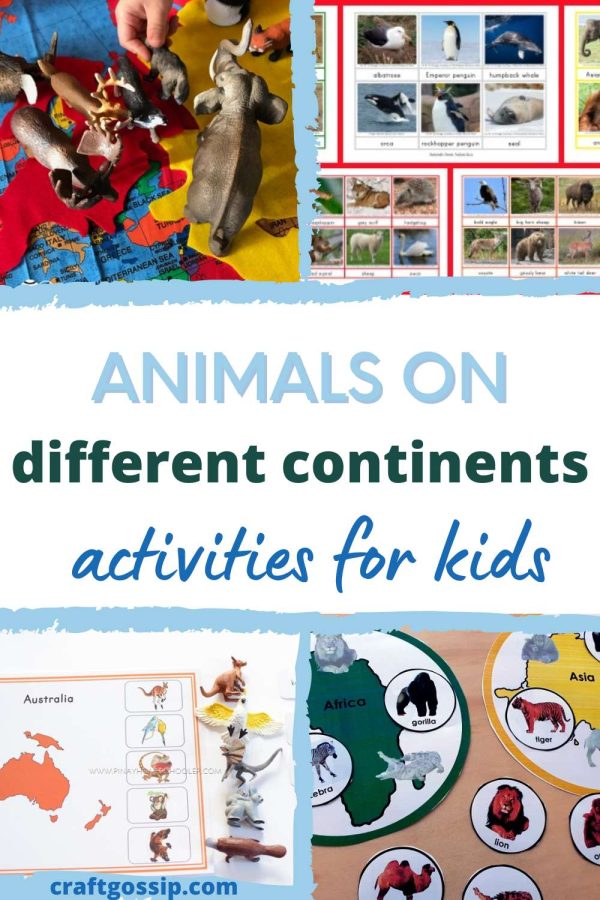
 Since I’ve been working on a nations of the world series for more than a year now, I’ve been thinking more about geography and how places are connected in ways that we might not always think about.
Since I’ve been working on a nations of the world series for more than a year now, I’ve been thinking more about geography and how places are connected in ways that we might not always think about.
And one thing that different nations on the same continent often have in common is the animals that live in the wild there. Little kids especially will love learning about different animals and the habitats in which they live with these resources.
Montessori Nature has a nice set of printables for each continent with different animals to math the ones shown on the map. (Free with email) These can be used on their own or with the animal TOOBs (this set for example includes the crocodile, gorilla, elephant and more). Match the animals with their pictures on the cards, or hide them in a sensory bin for kids to find and then sort by continent.
Mama’s Happy Hive has a lovely felt map of the world that she uses for continent activities, including matching animals to the continents they live on. Her animals all live in boxes organized by continent, which frankly I’m a little jealous of.
Gift of Curiosity has a set of free printable animal cards and a post all about how they used them as a map activity.
If you’re able to pay for resources, Chalk Academy has a great set of animals of the world cards that are available in English, Korean and simplified or traditional Chinese.
Pinay Homeschooler has a post all about using little animal figures with printables of the continents and their animals, and they have a set of printables for sale on Teachers Pay Teachers that includes maps of each continent showing five animals each that you can use with animal figures or by printing out animal cards to match those on the maps.
Learn about Croatia for Kids 17 Sep 7:31 AM (last month)
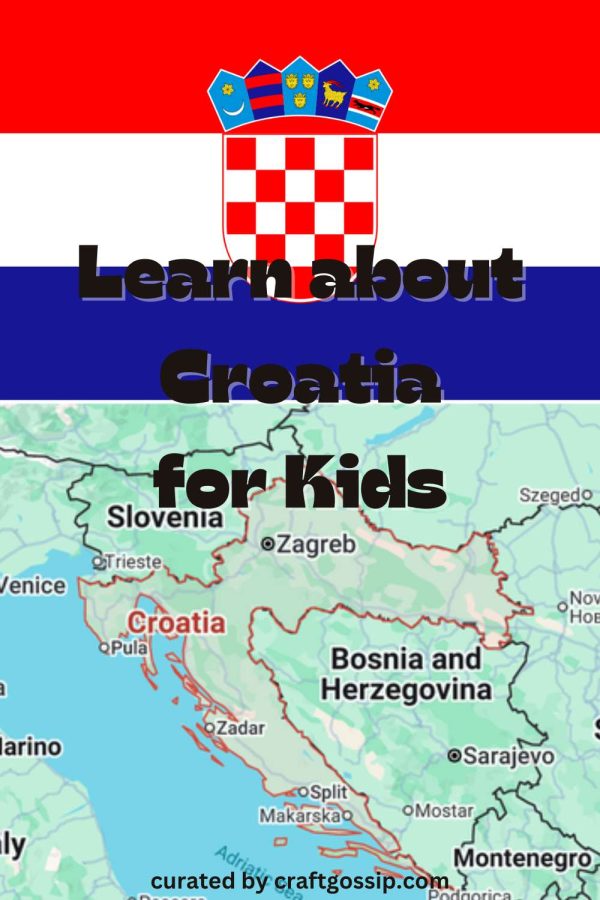
 Croatia is a country in southeastern Europe that was formerly part of Yugoslavia. It’s bordered by Slovenia, Hungary, Serbia, Bosnia and Herzegovina and Montengro, as well as the Adriatic Sea.
Croatia is a country in southeastern Europe that was formerly part of Yugoslavia. It’s bordered by Slovenia, Hungary, Serbia, Bosnia and Herzegovina and Montengro, as well as the Adriatic Sea.
Croatia Basics
Croatia measures 21,851 square miles, or 6,594 square kilometers, and is home to around 4 million people.
The capital and largest city is Zagreb.
Croatia was part of the Hapsburg Empire until it became part of an independent state of Slovenes, Croats and Serbs in 1918, which became part of the kingdom of Yugoslavia later that year. It declared independence in 1991 and fought a four year war to gain its freedom.
It is a democratic republic with a parliament, president and prime minister. The official language is Croatian, and nearly 92 percent of the country’s population is ethnically Croat.
Tourism is a major industry and the landscape includes mountains, plains and the coastal region.
You may remember that when we talked about Bosnia Herzegovina we noted that only one town in the country has access to the sea. There’s a short strip of land where the town of Neum is, with parts of Croatia on both sides. The Pelješac Bridge connects the parts of Croatia on either side.
There are more than 1,000 islands and islets that are part of Croatia, including 48 that are permanently inhabited.
Here’s a fun fact for you: the first necktie was a cravat worn by Croatian mercenaries hired by Louis XIII to fight in France in the 17th century. From there it became a part of the Croatian military uniform and eventually because fashionable in France for non-soliders.
Croatia National Symbols
The flag of Croatia features red, white and blue horizontal stripes, with the coat of arms in the center. The colors combine those used in the flags of the Kingdom of Croatia (red and white) and the Kingdom of Slavonia (blue and white).
The coat of arms includes a red and white checkerboard pattern on a shield and a crown with small images showing historic coats of arms of different regions of the country. The flag was adopted in 1990.
The checkerboard itself is considered a national symbol as it is found in some medieval churches in the country. Legend has it a Croatian king once played the Doge of Venice in chess for his freedom and incorporated the design into his coat of arms to commemorate his victory. The design has been used in the coat of arms of the Croat kingdom at least as far back as 1495.
The national anthem is “Lijepa naša domovino” or “Our Beautiful Homeland.” The original lyrics were published in 1835, with music composed in 1846. It was used as the state anthem in unofficial capacities for years, and parts of the anthem were used in the anthem of the Kingdom of Yugoslavia from 1918 to 1941. It was officially adopted in 1972.
Croatia is a majority Catholic country, and many cities have their own patron saint. The patron saint of Croatia as a whole is Saint Joseph, who has been considered the patron of the region since 1687.
The national flow is Iris crocatica, a bearded iris special that’s native to Croatia. The flowers are said to bloom where the Slavic god Perun’s lightning hits the ground, and they’re a protected species so they shouldn’t be picked.
The national animal is the European pine marten, a member of the weasel family found in most of Europe.
The Slavonian oak is the national tree. These trees are slow growing and traditionally used to make oak barrels for wine storage, as well as furniture and floors.
Croatian interlace is a particular ornamentation used in building and monuments in Croatian art and found on churches and monasteries in particular built between the 9th and 12th centuries.
Croatia Activities for Kids
Learn more about Croatia from National Geographic Kids. Case of Adventure has a free Croatia printables pack that includes things like a map, flags, fun facts, coloring pages, recipe cards and more.
Find country studies and more for kids of all ages (including information about the wars of the 1990s) at Teachers Pay Teachers.
Gingerbread is considered an intangible cultural heritage of Croatia that is recognized by the United Nations. They’ve been making gingerbread there since the Middle Ages and it is a true craft where gingerbread is made in intricately formed designs. The licitar heart is probably the most well known version that you’d find in bakeries and tourist shops. You can find a recipe at Chasing the Donkey (the recipe is from the Zagreb Tourist Board).
The page about Croatian interlace linked above has drawings you can print out and use as coloring pages.
Take a peek at old town Dubrovnik, a UNESCO World Heritage site that’s a well preserved Medieval town on the Adriatic coast.
Learn about the traditional folk clothing of Croatia and listen to some traditional Croatian music. And learn to tie a tie!